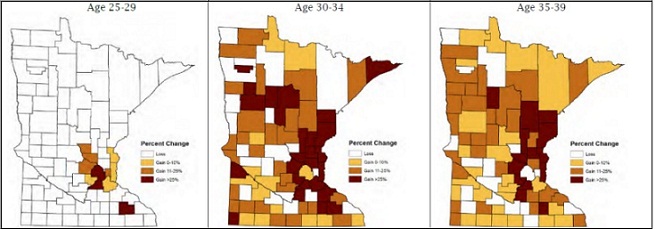Much is made of the fact that young people are leaving rural communities for jobs and education opportunities after high school. Much less is made of the fact that older households are continuing to move back to many of those same communities, according to new research by Benjamin Winchester, a research fellow at the Extension Center for Community Vitality at the University of Minnesota.
Winchester tracked five-year age cohorts from age 14 to age 65 from 2000 to 2010. He found that nonmetropolitan counties gained population in the 30-49 age range—a continuation of the trend seen in the 1990s, though the pace of growth had slowed somewhat, possibly in part to a slowdown of migration from the recession. Nonetheless, this migration pattern can be seen clearly from a snapshot of three age cohorts moving (generally speaking) from a job-search and career-building mentality to marriage and family-planning mindset (see maps below; due to technical constraints, maps with better clarity can be seen in the report itself).
County-level population change, 2000 to 2010, by age group (25-29, 30-34, 35-39)
Source: "Continuing the Trend: The Brain Gain of the Newcomers," University of Minnesota Extension Center for Community Vitality
The research did find that rural counties continued to lose young adults to metropolitan counties, mostly to the Twin Cities. In fact, Winchester found that migration preferences of all cohorts from 2000 to 2010 “are remarkably similar” to those found the previous decade.
One new finding was that micropolitan counties—those counties with regional populations of 10,000 to 49,000—appear to take on cohort migration traits similar to metropolitan counties. This was particularly the case in the southwestern portion of the state, where Winchester said “rural urbanity” appears to be attracting more 30-to-39-year-olds to places like Willmar and Marshall. He also pointed out that these micropolitan gains might ironically “exacerbate the narrative of rural decline,” because as these places grow, a few might reach metropolitan status, thus possibly shifting the migration ledger without any underlying change to the places people are moving to.
This research is an update of earlier research on rural brain gain, which Winchester talked about in a July 2011 interview with the fedgazette.
Ron Wirtz is a Minneapolis Fed regional outreach director. Ron tracks current business conditions, with a focus on employment and wages, construction, real estate, consumer spending, and tourism. In this role, he networks with businesses in the Bank’s six-state region and gives frequent speeches on economic conditions. Follow him on Twitter @RonWirtz.





